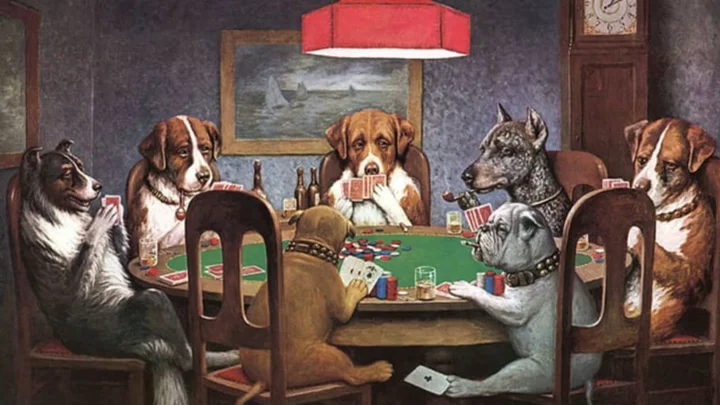Thanks to Dogs Playing Poker, painter Cassius Marcellus Coolidge (a.k.a. C.M. Coolidge) has earned the dubious distinction of being called “the most famous American artist you’ve never heard of.” But while critics might sniff at his contribution to the art world, the history of his greatest works is rich.
1. Dogs Playing Poker is actually a series of paintings.
Coolidge’s earliest explorations of dog paintings were made for cigar boxes. Then, in 1903, the 59-year-old artist started working for the “remembrance advertising” company Brown & Bigelow. From there, he began churning out works like A Bold Bluff, Poker Sympathy, and Pinched With Four Aces, which were reproduced as posters, calendars, and prints, sometimes as parts of promotional giveaways.
2. The most popular of these paintings is of dogs cheating at poker.
A Friend in Need pits a pair of bulldogs against five huge hounds. Who could blame them for slipping helpful cards under the table with their toes? As the most beloved of this series, A Friend In Need is also the one most often misnamed “Dogs Playing Poker.”
3. These paintings gave C.M. Coolidge some fame in his sixties.
Coolidge already had a quirky artistic claim to fame—he’s credited as the father of Comic Foregrounds, those carnival attractions where tourists can stick their heads atop a cartoon figure as a photo op. But with Dogs Playing Poker catching on through calendar and poster sales, Coolidge was able to sell some of the original paintings for $2000 to $10,000.
4. Dogs Playing Poker has never received much critical praise.
These painting, which were commissioned for commercial use, are regarded most often as kitsch, art that is basically bad to the bone. Recounting the highbrow opinion of these pieces, Poker News’s Martin Harris explained, “For some the paintings represent the epitome of kitsch or lowbrow culture, a poor-taste parody of ‘genuine’ art.”
5. The paintings became a staple in working class home décor anyway.
In the 1970s, kitsch was king, and demand for Dogs Playing Poker hit its peak—which made the pooches readily available in various affordable forms. Or, as art critic Annette Ferrara put it, “These signature works, for better or worse, are indelibly burned into the subconscious slide library of even the most un-art historically inclined person through their incessant reproduction on all manner of pop ephemera: calendars, t-shirts, coffee mugs, the occasional advertisement.”
6. They could be seen as a sort of self-portrait.
Coolidge went by the nickname “Cash” and has been described as a hustler whose résumé showed quite a few career changes. Before he was painting for calendars, he worked painting street signs and houses and also tried his hand at being a druggist, an art teacher, and cartoonist. He also started his own bank and his own newspaper. So perhaps the pooches who are always looking for the angles represented Coolidge’s own ambitions.
7. Kitsch or not, Dogs Playing Poker paintings sell for big bucks.
A 1998 auction saw a Coolidge original sell for $74,000 at Sotheby’s. Then, in 2005, A Bold Bluff and Waterloo: Two were put up for auction in Doyle New York’s Dogs in Art Auction. Before they hit the block, predictions were made that the pair of rare paintings would fetch $30,000 to $50,000. But an anonymous bidder ultimately paid a whopping $590,400 for them. “A lot of people came to speculate on the piece, a lot of whom were outside our traditional area of collectors,” Alan Fausel, then the senior vice president of paintings at Doyle, told CNN. “It was a once in a lifetime opportunity.” In 2015, that record-breaking price was surpassed when Coolidge’s Poker Game sold for $658,000.
8. A Bold Bluff and Waterloo: Two share a storyline.
Auction notes from the Doyle event explain, “The [paintings’] sequential narrative follows the same ‘players’ in the course of a hand of poker. In the first (A Bold Bluff), our main character, the St. Bernard, holds a weak hand as the rest of the crew maintains their best poker faces. In the following scene (Waterloo: Two), we see the St. Bernard raking in the large pot, much to the very obvious dismay of his fellow players.”
9. Not all of the Dogs Playing Poker series fit the name.
Coolidge painted 16 pieces within this collection, but only nine of them actually show dogs playing poker. Higher Education displayed helmeted pups playing football. New Year’s Eve in Dogsville imagines a romantic soiree with dinner and dancing dogs. And Breach of Promise Suit showed a canine court.
10. Dogs Playing Poker has a small place of honor in Philadelphia, New York.
Coolidge was raised in Philadelphia, but the town was largely unaware of the fame of their former resident until 1991. That’s when his then-80-year-old daughter Gertrude Marcella Coolidge took it upon herself to travel to Philadelphia, New York, and give a print from his collection to the town. Today, the piece is framed and hangs within the one-room museum at the back of the local library. Visitors can also ask to see a thin folder of related Coolidge materials.
11. Coolidge’s wife and daughter were unimpressed by Dogs Playing Poker.
In 2002, 92-year-old Gertrude told The New York Times that she and her mother were more cat people than dog lovers, but she admitted, “You can’t imagine a cat playing poker. It doesn't seem to go.”
12. Dogs Playing Poker have been compared to Tennessee Williams’s plays.
Maybe that sounds silly. What do plays like Cat on a Hot Tin Roof or Streetcar Named Desire have in common with these kitsch masterpieces? According to New York Times contributor James McManus, these works share similar views on sexual politics: “Men drink, bellow, smoke and play poker. The women who serve them … their game is to tame the bad boys.”
For Williams, this means Maggie the Cat, Stella Kowalski, or her frail sister Blanche DuBois. For Coolidge, it means a cocktail-serving poodle, or a pair of terriers breaking up the game.
13. Coolidge pulled inspiration from great artists who came before.
The works of Michelangelo Merisi da Caravaggio, Georges de La Tour, and Paul Cézanne are often cited as influences on how Coolidge posed his canine card players.
14. The art elite still give Dogs Playing Poker no respect.
Popularity and prestige don’t always come hand in hand. Art critics have long sneered at the commissioned works Coolidge undertook. Even his 1934 obituary described his greatest artistic accomplishment as “painted many pictures of dogs.” But a low blow was delivered one April Fool’s Day when the Chrysler Museum of Art in Norfolk, Virginia, posted a prank in the form of a press release proclaiming the institution wanted to exhibit Dogs Playing Poker.
Chrysler Director William Hennessey was quoted as saying, “There’s long been a spirited debate in scholarly circles about the position of canine art within the canon. I believe it is now time for these iconic images to assume their rightful place on the walls of our institutions where homo-centric art has too long been unjustly privileged.”
This praise was followed by an addendum: “EDITOR’S NOTE: April Fool! Every word printed above is true with the single exception of the suggestion that the Chrysler is actually trying to obtain these paintings.”
15. Dogs Playing Poker is popular in pop culture.
Coolidge’s paintings have popped up everywhere from classic TV shows like Cheers (Sam is a fan), The Simpsons (Homer is not, as you can see in the clip above), and Rosanne to the cover of Rush’s 1981 album Moving Pictures, which features A Friend in Need to shows like The Suite Life of Zack and Cody and Boy Meets World.
A version of this story ran in 2015; it has been updated for 2023.
This article was originally published on www.mentalfloss.com as 15 Things You Should Know About ‘Dogs Playing Poker’.









